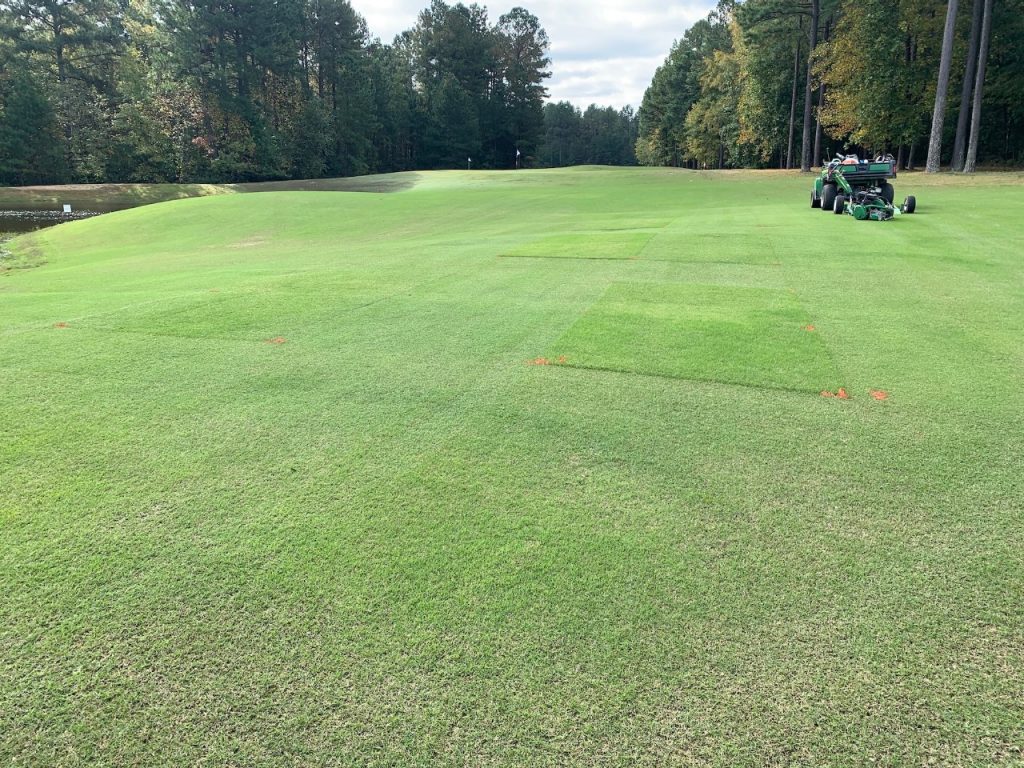
A satisfying thwack and a small, white ball vanishes into the horizon. The ball slowly drops into a hole after a seemingly gravity-defying moment. These are the moments that golfers live for, and the moments that golf superintendents and their crews work tirelessly to create.
At Independence Golf Club in Richmond, a unique partnership exists between Virginia Tech’s College of Agriculture and Life Sciences researchers and industry professionals that helps make these memorable moments on the putting green. The unique agreement allows research to be conducted on an active golf course with true feedback on playing surface quality, a rarity in the field.
A few years ago, researchers from Virginia Tech were approached by Giff Breed, owner of Independence Golf Club that houses an 18-hole championship course and a 9-hole par 3 course, about using warm-season grasses at the course instead of the northern grasses typically used in the region, making work much easier for course superintendents in the hottest months.
“Not a whole lot was known about how these were going to respond in this part of the country,” said David McCall, an assistant professor in the School of Plant and Environmental Sciences and member of the research team. “Warm-season grasses in varied climates were new to everyone, and Giff was curious about how it would respond. It naturally evolved into trying out as many different grasses as we possibly could.”
The research started with 10 varieties of grass under consideration for putting greens and tees but has since narrowed significantly with ultradwarf bermuda grasses as the primary turfgrass studied because of how varieties naturally rose to the top. The bulk of the research takes place on the par-3 course. The researchers work closely with Golf Course Superintendent Dan Taylor, the Certified Golf Course Superintendents Association of America, and Breed.
Ultradwarf bermudagrass is a warm-season turfgrass, bred to be managed at very low mowing heights, that grows best in the heat of the summer when golf rounds in Virginia are at their peak. While ultradwarf bermudagrass can be managed to provide excellent golf putting greens in warmer climates, it is a challenge to keep alive through cold winters. Creeping bentgrass, which was previously used at the course, flourishes in northern climates under moderate temperatures but is difficult to maintain in the heat and humidity typical of Richmond summers.
While creeping bentgrass remains the norm for most putting greens in Virginia, Independence is demonstrating how well-managed bermuda grass putting greens can play firm and fast during some of the heaviest play periods, desirable traits amongst golfers.
The Virginia Tech researchers have used a variety of methods to keep ultradwarf bermuda grass alive in the winter, which include regular installation and removal of blankets and plant growth regulators, chemicals that slow plant growth.
In Richmond’s climate, the combination was successful until a frigid winter in 2018 when the team lost some of the ultradwarf bermuda grass on both its research course as well as the championship course.
The use of warm-season grasses could also benefit smaller golf courses with limited budgets that typically use native soil greens without internal drainage. Ultradwarf bermuda grass, despite a less-than-stellar perception, could be easier for these golf courses to maintain during the stresses of summer, providing high-quality putting greens while not requiring nearly as much water and other inputs as bentgrass greens during warm months.
The work of Virginia Tech researchers impacts how golfers can approach their game in the region. When a golfer takes a putt and watches it drop into the hole, it won’t just look like a championship moment. It will be on a championship-caliber surface.



